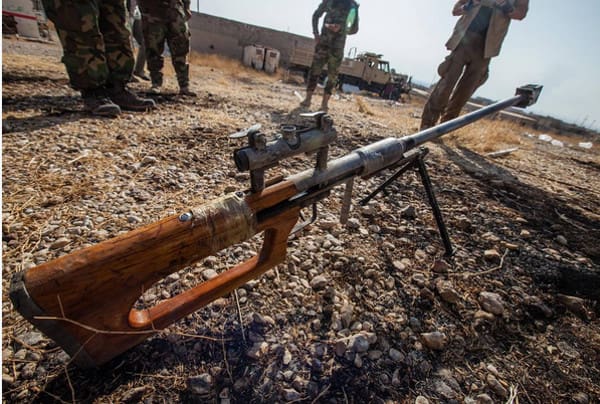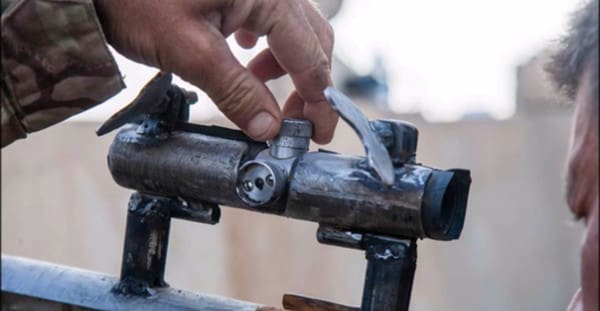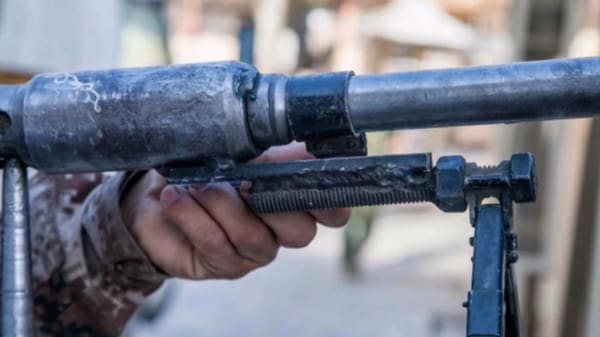https://youtu.be/MHgwgC0-CEo
Jake Hamby has posted photographs of a small shop-manufactured .50 caliber single shot, scoped rifle. The rifle was captured from ISIS forces in Iraq. Many on the Internets are disparaging the rifle, characterizing it as a “face bomb” waiting to go off. Yes, well . . .

It’s a mistake to judge a weapon by its exterior finish. Sure, guns like a pre-1940 commercial Mauser or pre-’70’s Colt are known for their excellent polish and bluing. But if you look at military production models, you’ll find perfectly useful and effective weapons with crude finishes. In fact, Webley put a “war finish” stamp on some of their revolvers — presumably out of embarrassment. The interior of their revolvers was very effective.
You can’t get a better reason for a “war finish” than the conditions ISIS is operating under. I would be willing to test fire it — if I were allowed to disassemble and examine the mechanism first. From an Internet examination, it seems to be a serviceable design.
Don’t discount the ability of the rifle to get rounds downrange with useful accuracy. Most of the needed accuracy would be in the barrel, which may be a standard barrel from another weapon.
If the barrel was made in a shop, that is a significant achievement. It may have been locally produced. ISIS contains decent lathes and milling machines in the territory it has conquered. The tack weld locking the barrel to the receiver is highly unconventional, but it works.
I suspect a Savage model 110 type of locking lug arrangement. Depending on the heat treatment of the receiver and locking lugs, the set up could last from a couple of hundred rounds to many thousands. Given the rifle’s environment, a couple of hundred rounds may be a realistic service life.

The rifle’s designers tackled this problem with two solutions. First, the mounting system is extremely sturdy and welded directly to the receiver. Integral scope mounting systems are the best way to avoid problems. They have to be reasonably aligned with the bore. A simple bore sighting system used while welding on the mounts would allow for that alignment.
Second, there is the rubber bicycle innertube buffer between the scope and the mount. The oversized turnbuckle bolts used for tightening the mount to the scope use a lot of surface area to grip the scope. Whether the rubber buffer provides enough cushion to keep from battering the scope apart under the recoil of .50 BMG rounds would be a matter tested in practice. Again, a couple of hundred rounds service life is likely enough.
The bipod is adjustable for height and ground irregularities.
Headspacing problems would probably show up on the brass before the rifle would allow brass rupture from case separation. If you examined the fired brass, you could figure out when you would need to adjust the headspace. If not, the horizontal bolt and loading slots vent high pressure gases and molten brass to the sides, away from the face.
The inline, straight stock does much to soak up perceived recoil. The muzzle brake looks effective.
If the barrel is a standard .50 cal, a fixed 3.5 power scope should allow hits on man-sized targets to 800 yards. The scope does not have a rangefinding reticule. The vertical adjustments are calibrated out to 1300 meters for the 7.62×54 cartridge. It wouldn’t be hard to determine the range equivalents for the .50 BMG. An over the counter laser rangefinder would be a force multiplier for this rifle
This rifle, while of crude finish, can likely fire .50 BMG to good effect. Those who want to outlaw .50 BMG in the United States should take notice. It’s up to us to bring it to their attention.
©2016 by Dean Weingarten: Permission to share is granted when this notice and link are included.





“And in other news, thetrace.org has identified Royal Nonesuch as the main source of ISIS’ homemade weapons”
Awe man! I thought they bought at Texas gun shows!
It makes me wonder what goal they had in mind for this rifle. 50 is way overkill for a simple anti personnel rifle, and there’s no way that scope is giving you the full reach of the caliber, so what’s the point of this rifle? Did they simply have a ton of 50 laying around they needed to use? Is this for some sort of anti vehicle role?
Good points. Whether it succeeded at it or not, could have been intended to be a Barrett anti-materiel analogue.
Not having “the full reach of the caliber” is not all that important. Having enough to be useful is. If the rifle barrel is a standard .50 caliber, the rifle can likely hit material targets to 1500 meters, especially if a laser rangefinder is used.
You do not even need a laser rangefinder if you have mapped the area well and have GPS.
Useful in a city environment. Security forces are probably using only lightly armored vehicles. And their checkpoints and admin buildings are probably full of areas were a .50 bmg weapon can cause all sorts of damage.
A man portable weapon that’s good enough in that environment and packs more punch than the ak that is in general use there.
And while it’s no rpg the ammo is cheaper, can be easily and safely carried in greater quantities and doesn’t have a back blast to worry about.
Urban combat. Allows for penetrating light armor and barricades, and distance are already known, because they are previously mapped out.
I agree with the other commenters.
Note that 800 meters is one-half mile and a highly useful range for urban combat.
Hey a .50 pipe rifle in real life. Actually kinda looks like the fallout pipe rifles too.
One does one’s best
Yeah, you go to war with what you have. Not what you wish you had.
Is this a Royal Nonesuch design? If so, Serbu is gonna sue your ass ISIS!
Nonesuch’s 50 BMG design uses a threaded breech cap…
Is that clear packing tape I see? I guess those primitive jihadassholes never heard of duct tape.
Kipling understood the value of cheap but effective weapons and manpower. From Arithmetic on the Frontier:
Two thousand pounds of education
Drops to a ten-rupee jezail —
The Crammer’s boast, the Squadron’s pride,
Shot like a rabbit in a ride!
I’m rather fond of another Kipling poem:
“When you’re wounded and left on Afghanistan’s plains,
And the women come out to cut up what remains,
Jest roll to your rifle and blow out your brains
An’ go to your Gawd like a soldier.”
In times of war, duct tape is one of the first things to be rationed.
What I’d like to know, about how much does a 50 BMG deep drill run and how many barrels could one expect it to drill with it before needing sharpening?
What’s all this about woodchucks now?
I’m not interested in woodchucks unless they’re busy chucking the wood I neglected to split last summer…
🙂
You have to hope a lot of those home brewed guns do blowup when fired. I made a zip gun as a kid from a car antenna, wood clothes pin, rubber band and a paper clip. Don’t need much else to fire a 22LR no duct tape back then just adhesive tape. Id be hopping every one of those 50bmg blows up and takes the user with it.
Yup. I never had a zip gun blow up on me or any people who used them.
…Ahhh, the ancient wisdom of Kipling—too bad that no one ever listened !!!! Adorable Deplorable DMD
Overall it’s impressive.
As a recovering welder however, I would say that ISIS welders don’t take much pride in their work and quite frankly don’t really know much about what they’re doing. I’d be shocked if those welds held up over a long period of use.
“Silence! This thing called ‘excessive undercut’ you speak of Abdul it is only a lie of the infidels!”
HA! A haji joke and welding joke in one.
Well played.
strych9,
If that muzzle brake is as effective as it looks, recoil is probably surprisingly mild depending on the overall weight of that rifle. If recoil is as mild as it could be, the welds will probably last a lot longer than you think.
About a year ago, I used a recoil calculator to compare the recoil of a .50 BMG rifle with a quality muzzle brake to the recoil of my Mossberg 500 pump-action shotgun with rifled slug barrel with no muzzle brake. At first blush, everyone (including myself) would claim that the .50 BMG recoil was orders of magnitude more brutal than the shotgun. Surprisingly, when you add the dampening effect of the .50 BMG rifle’s 23 pounds and muzzle brake (compared to the shotgun’s 7 pounds and no muzzle brake), recoil is about the same.
Here are the numbers:
.50 BMG launches a 660 grain bullet at 2,800 fps.
12 gauge launches a 300 grain bullet at 2,000 fps.
The product of bullet mass and velocity is only 3 times greater for .50 BMG … and the .50 BMG rifle weighs more than 3 times greater than the shotgun!
That simple analysis failed to account for the fact that the .50 BMG rifle has more gas exiting the muzzle which would increase its recoil. At the same time, that .50 BMG rifle has a mzzle brake which redirects a lot of that gas to reduce recoil.
In the end recoil is about the same between a heavy (23+ pound) .50 BMG rifle with a muzzle brake and an average pump-action 12 gauge shotgun with a rifled slug barrel. Unsurprisingly, pump-action shotguns seem to withstand hundreds/thousands of rounds without any of their small welds failing. I expect similar results with that .50 BMG rifle.
Recoil is not what I’m thinking of. Even shitty welds generally won’t just shake apart under the stress of firing that thing.
The problem is that as the gun gets hot and/or the metal flexes during firing due to pressure the undercut and cracking will transfer heat and stress unevenly creating sheer forces on the welds or along their edges. Those welds have visible tube cracks which makes them very prone to catastrophic longitudinal cracking when they’re not under serious stress, add in stress, especially the rapid pressure spikes of firing that thing and it’s a problem.
On top of that the weld between the barrel and the chamber/receiver there isn’t even close to full pen. See how it rolls over and is all globby? It’s just sitting on the surface of the welded materials rather than penetrating them. That’s the kind of weld that a good whack with a hammer sometimes removes.
This looks like shitty stick welding to me. Really shitty stick welding. Their amperage is too low, their arc length is too short and their travel speed is way, way off in the too fast direction. Whoever did this literally knows nothing about a welder other than how to turn it on and make sparks.
I do not think the chamber/barrel weld is what holds the barrel to the receiver. I think that weld is just to keep the barrel from turning. The scope mount welds, yes they could fail. But a couple of hundred rounds is a pretty useful service life in that combat, likely.
“Don’t judge a book…”
Yeah, because bad welding and tape just screams ‘quality internals.’ From what I’ve seen, the bolt handle is the breechlock; like on a 22LR. I’d have little hope the gun can survive more than a few shots before the handle/slot peens and begins increasing headspace to failure, assuming it doesn’t sheer outright & kill the rifleman. I’ve also seen it claimed this same gun was captured from every side of the war, so the claims of provenance are dubious.
If you look closely, you can see the handle is only a safety lug at most. The action is not locked by the handle. The locking lugs are on the bolt head, inside the receiver, where they are not visible.
My first impression was the handle was a locking lug, but it isn’t.
Sorry, bud. It looks like a POS to me, and that dinky POS scope about 2″ above the bore ain’t gonna do squat for hitting anything more than the broad side of a barn.
You’re welcome to try it if you like. It’s your face and your life. I’ll have 911 on fast dial for you.
Charlie
“That scope” was used by Soviet snipers to regularly make hits on man sized targets to 800 meters. That was using the 7.62×54 cartridge.
Looks like it could pass for a modern Marlin rifle today.
Freedom Groups new rifle submission to the next SHOT Show.
can everybody simmer down, people might hear you and theyll ban pipes and welding stuff, shhhhh…..
possibly a Russian or Chinese barrel in .51 caliber, Crude not pretty, possibly effective, even if shot once and hit its target with out killing its operator it did its job, and the dude on the receiving end could care less!
I wondered if it might be a 12.7×108 barrel and rounds. No one reporting seemed interested in doing actual measurements or even checking ammunition or headstamps.
Comments are closed.